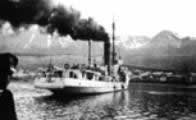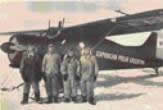ARGENTINe ANTaRcTIC EXPEDItIONS
ARGENTINE ANTARCTIC CAMPAIGNS
In 1939, the need for a centralized body dedicated to the defense and development of our Antarctic interests gave rise, a year later, to the creation of the National Antarctic Commission, under the Ministry of Foreign Affairs and Worship.
Based on a recommendation from the Commission and on a plan prepared by the Naval Hydrography Service, the 1942 Antarctic expedition was organized, under the command of the Frigate Captain Alberto J. Oddera, aboard the Ship 1º de Mayo reaching Decepción Island. on February 6, 1942. On February 8, Captain Oddera took formal possession on behalf of the Argentine government of the Antarctic Sector, depositing the certificate in a cylinder that remained on the island. This ceremony was then repeated in the Melchior archipelagos and the Argentine islands. He also carried out important hydrographic and cartographic work, installed the first Argentine lighthouse on the current May 1 island (Melchior Archipelago) and carried out biological and geological work with personnel from the Bernardino Rivadavia Argentine Museum of Natural Sciences.
In 1943 another Antarctic campaign took place that completed the studies begun by the previous one and reached the waters of Margarita Bay, where it rescued the instruments abandoned at the East Base by Byrd's North American Expedition. The result of both expeditions was a great cartographic enrichment, magnetic declination hydrographic, meteorological, tidal, aerial surveys and collection of biological, geological and glaciological samples, as well as signaling work with lighthouses and beacons. The foundations had been laid for a future expansion of Antarctic activity, which was not long in coming: in the 1946-1947 campaign, the Melchior detachment was created and a reconnaissance flight was carried out beyond the Polar Circle under the command of Rear Admiral Gregorio Portillo. . A year later, the Deception detachment was installed and equipped with a seismographic station and volcanological studies, and a refuge was built on the Antarctic Peninsula in Andvord Bay.
The execution of Antarctic activities during the 1940s had been the responsibility of the navy, but at the end of this period the other forces quickly joined the task of the white continent and new personalities contributed their effort to the exploration and recognition of the Sector as what was the then colonel Hernán Pujato,
In 1949 he drew up an ambitious plan which was fulfilled in all its points: he rented the cargo ship “Santa Micaela”, due to the difficulties in finding a ship that would transport men and materials and March 21, 1951 he installed the San Martín Base in Bahia Margarita, on April 17, 1951 creates the Argentine Antarctic Institute; He managed before the national government the purchase of the icebreaker "General San Martín" in 1954, he carried out his first Antarctic campaign in 1955 in which the General Belgrano Base was installed in which he starred in the first wintering, and the realization of the first Terrestrial Expedition Argentina to the South Pole in 1965 under the command of then-Colonel Jorge E. Leal, called "Operation 90", they left the Belgrano Base in October 1965, and arrived on December 10 of that year fulfilling the objectives of propping up, for a On the other hand, the Argentine presence in its southernmost limit and, on the other, the scientist when making observations and obtaining valuable information for various lines of research as well as new experiences on polar techniques. Gustavo Giró Tapper was the advance and 2nd chief of “Operation 90” and founder of the Doctor Sobral Base at 81º 04'45 ”that supported that expedition. Jorge Leal founded Esperanza Base in 1952. Gustavo Giró Tapper was the head of the 1962 winter expedition of Esperanza Base-San Martín Base-Esperanza Base, which traveled 2000 km over the Antarctic mountain range, baptizing two peaks, América and Santa Micaela , in honor of the ship that transported H. Pujato in 1951.
(Antarctic Museum Rooms 5 - 8)



